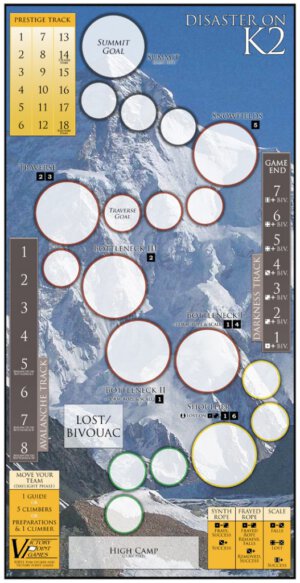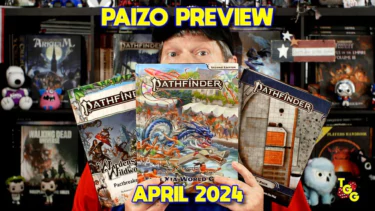Publisher: Victory Point Games
Designer: Tom Decker
Artists: Scott Everts and Ray Flowers
Year: 2011
Players: One or two players
Ages: 10+
Playing Time: 45 Minutes
Retail Price: $22.95
K2 is the second highest mountain on Earth, after Mount Everest. (Side Note: VPG also publishes Disaster on Everest, with similar mechanics as K2 but with different events and a different disaster. The games can be played together as a campaign). It is located on the border between Pakistan and China, and is known as “The Savage Mountain” due to the difficulty of ascent and the high number of fatalities. One out of every five people who reach the summit dies in the attempt.
As you might expect then, Disaster on K2 will not be an easy game. What’s the disaster? At a certain point in the game, there will be an avalanche and part of the mountain will come crashing down on any unlucky or slow climbers.

The adventure starts when you select a team of five climbers from the hopeful applicants. You must choose either the Serbian, Netherlands, Norway, or South Korean team. You have a choice of hiring either a Sherpa or a HAP (High Altitude Porter). If you select a Sherpa, they will have a goal of their own that will raise your score if they achieve it during the climb. The HAP has two skills though, while the Sherpa has only one.
Your climbers ascend to the High Camp, the bottom space on the map located at 25,800 feet. The map is nice and has a full color picture of K2 in the background, with all of the spaces, tracks, and info you need to play right on it.
The tokens for each climber indicate their movement ability. The trick here is that some climbers move zero spaces, the only way they are going to ascend is with help from the guide. Luckily, the guides get extra movement and can assist other climbers.
There are two tracks on the board to handle game length. The avalanche track is where you begin and is the unique part of the game. There is also a prestige track. In a solo game you start with 18 prestige points, in a two player game you each start with 14 points. Each turn, you will pull an event token out of a container. These events can be good or bad, but they only occur if someone purchases them with prestige points.
Why would you purchase a bad event? Because every event that is not purchased is placed on the avalanche 
Let me go into a little more detail here. You pull an event token out and look at it. Let’s say for example it says “Broken Rope”. The token has a prestige cost of one point, which is the cheapest you can get. If you buy it, the rules say you must select a climber and roll a die. If you roll a one, the climber falls to their death. On a 2-4, they are injured and have to go back to the High Camp immediately. On a 5-6, nothing happens. You have to decide whether it is worth the risk to keep from adding a token to the avalanche track, bringing you closer to a collapse and oncoming darkness. Once your prestige is spent, it is gone forever, so a cost of one is cheap to keep from adding the token. I made this choice twice in one game, rolling a one both times and sending two climbers to their deaths.
There is also another number on the event token that applies regardless of whether the event is played or not. Each space on the board that matches this number has a “Blocked Ridge” token placed on it. A blocked ridge can only be passed by guides and climbers with the skill to do so. The blocked ridges change every turn when a new event token is pulled.
After the event token is pulled, the climbers can move. You can choose to either move all climbers their movement rate, or move your guide to assist climbers, but not both. Some climbers have a movement of zero, so only a guide can help them move. These are worth the most victory points of course if you can get them to the summit. A guide can move multiple climbers, but only one at a time. So if they have a movement of six, they can move a climber two spaces, go back two spaces, and move another climber two spaces, for a totals of six.

When a climber reaches the point called the traverse, they place a traverse marker on their space on the scoring track. This will net you four points at game end. When they reach the summit, the summit marker is placed on the track and you earn their full victory point value, if they survive the climb down.
On your way down, darkness usually sets in. Movement is reduced for those without a resolute guide to help them, or a flashlight, which is another event token you can purchase if you are lucky enough to pull one. You can choose to Bivouac (camp) those climbers who won’t be able to make it down in time. This involves rolling on a chart that is more difficult the higher up the climber is. If successful, you camp your climber and then will learn at the end of the game whether or not they survive.
Those who cant camp must hurry down the mountain. If you have a rope (also an event you can purchase) then it isn’t too difficult to get past the avalanche. If you don’t, then you must attempt to scale down the mountain. The risk of death is much greater when scaling.

Disaster on K2 is challenging. The theme shines through, at no time did I think I was doing anything else than trying to scale this mountain. The challenge keeps pushing me on to play again with different strategies. There are other options you can try that I didn’t even discuss, like making preparations, which cost you time but can give a measure of control over events for a while. After you learn how to play, the game moves quickly and you can finish a single game in less than 45 minutes. So far, the best I’ve been able to manage is 17 points, which is terrible. Dead climbers cost you negative points and mine seem to leap off of the mountain at every chance they get.
I have minor quibbles. Some of the rules took a little thinking about for me to understand. For example, a climber with the Fortitude trait can carry another climber for one space. But is that the end of their movement, or do they get to finish the rest of their movement on their own? I decided they could finish their movement, because that is how the guides work. The whole climbing down past the avalanche seemed fuzzy to me too, but I found I was playing it correctly after checking into it online. The last really minor issue is the difference between the Serbian and Netherlands tokens. Serbian is red, blue and white striped while the Netherlands is red, white, and blue striped. So it is easy to mix the two up.
I think it is great that K2 can be played with Disaster on Everest. In fact, K2 allows you to play Everest as a two player game, which was originally only a solitaire game. Nice bonus if you own both.
Disaster on K2 is a combination of luck and strategy. I don’t find the luck piece detrimental though, because actually climbing K2 would involve the same elements. The game is the closest I ever really want to get.
- A Dungeon Delve for Kids?: A Review of Dungeon! - Oct 24, 2022
- Better, Stronger, Faster | Descent: Journeys in the Dark Second Edition Reviewed - Oct 23, 2022
- Your Planet is Doomed!: Invasion from Outer Space Reviewed - Oct 22, 2022













